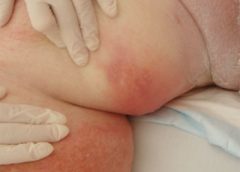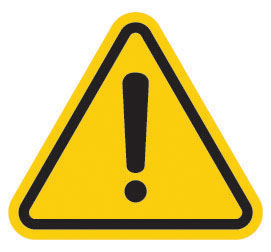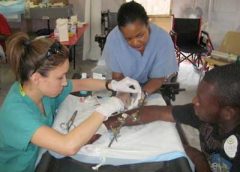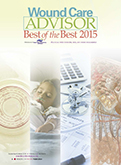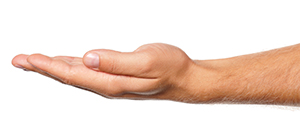Posted: September 17, 2015
By: Donna Sardina, RN, MHA, WCC, CWCMS What do the Los Angeles Lakers, Green Bay Packers, Montreal Canadiens, and New York Yankees have in common? All three have “three-peated”, meaning they have won three consecutive championships. This year, we at Wound Care Advisor, the official journal of the National Alliance of Wound Care and Ostomy (NAWCO), mark our own three-peat—our…
Posted: September 17, 2015
Mild compression diabetic socks safe and effective for lower extremity edema Diabetic socks with mild compression can reduce lower extremity edema in patients with diabetes without adversely affecting arterial circulation, according to a randomized control trial presented at the American Diabetes Association 75th Scientific Sessions Conference.
Posted: September 17, 2015
The resources below will help you address issues in your practice. NPUAP position statement on hand check for bottoming out Use of the hand check to determine “bottoming out” of support systems should be limited to static air overlay mattresses, according to a position statement from the National Pressure Ulcer Advisory Panel (NPUAP).
Posted: July 21, 2014
By Jennifer Oakley, BS, RN, WCC, DWC, OMS It’s time again for annual staff education, and you, the certified wound clinician, need to teach the staff at your organization. You dream of staff entering a state-of-the-art classroom with computers at each station, mannequins, wound anatomy models, and enough products for each student to do hands-on demonstrations. But when you open…
Posted: April 6, 2015
By Jeri Lundgren, BSN, RN, PHN, CWS, CWCN A declining pressure ulcer decreases the quality of life for patients and places providers at risk for regulatory citations and litigation. But it’s important for clinicians to determine whether the first appearance of skin injury is truly a stage I or II pressure ulcer or if it’s a deep tissue injury (DTI),…
Posted: May 19, 2015
By Cindy Barefield, BSN, RN-BC, CWOCN Like many hospitals, Houston Methodist San Jacinto Hospital uses national benchmarks such as the National Database of Nursing Quality Indicators (NDNQI®) to measure quality outcomes. Based on benchmark reports that showed an increased trend of pressure ulcers in critically ill patients in our hospital, the clinical nurses in our Critical Care Shared Governance Unit-Based…
Posted: May 21, 2015
By Beth Hoffmire Heideman, MSN, RN No one wants an ostomy, but sometimes it’s required to save a patient’s life. As ostomy specialists, our role is to assess and intervene for patients with a stoma or an ostomy to enhance their quality of life. We play an active role in helping patients perform self-care for their ostomy and adjust to…
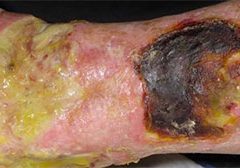
Posted: March 25, 2014
By Nancy Morgan, RN, BSN, MBA, WOC, WCC, DWC, OMS Each issue, Apple Bites brings you a tool you can apply in your daily practice. Exudate (drainage), a liquid produced by the body in response to tissue damage, is present in wounds as they heal. It consists of fluid that has leaked out of blood vessels and closely resembles blood…
Posted: February 9, 2015
By Nancy Morgan, RN, BSN, MBA, WOC, WCC, DWC, OMS Each issue, Apple Bites brings you a tool you can apply in your daily practice. Medical gauze, a bleached white cloth or fabric used in bandages, dressings, and surgical sponges, is the most widely used wound care dressing. Commonly known as “4×4s,” gauze is made from fibers of cotton, rayon,…
Posted: February 9, 2015
By Gail Rogers Hebert, MS, RN, CWCN, WCC, DWC, OMS, LNHA The World Health Organization defines palliative care as “an approach that improves the quality of life of patients and their families facing the problem associated with life-threatening illness, through the prevention and relief of suffering by means of early identification and impeccable assessment and treatment of pain and other…
Posted: May 21, 2015
By Darlene Hanson, PhD, RN; Diane Langemo, PhD, RN, FAAN; Patricia Thompson, MS, RN; Julie Anderson, PhD, RN; and Keith Swanson, MD Cellulitis is an acute, painful, and potentially serious spreading bacterial skin infection that affects mainly the subcutaneous and dermal layers. Usually of an acute onset, it’s marked by redness, warmth, swelling, and tenderness. Borders of the affected skin…


